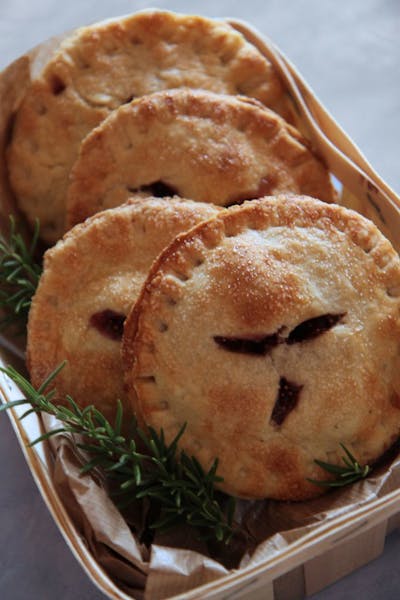AUTIGNAC, France
This is a hot, dry region. By all rights, it shouldn't produce anything as sumptuously lush as grapes and figs.
But from September into early October, the usually thrifty Languedoc puts on a brief show of opulence. Vines droop everywhere with heavy blue clusters, and fig trees, having spent the summer sucking deep from rocky ground, suddenly decide they can afford to be almost tropically wasteful.
Figs are everywhere.
They are like those impossible-to-kill mulberry trees back home that sprout prolific volunteers and lean over fences to spill black- and plum-colored stains onto the July sidewalks of Minneapolis. Here, figuiers grow up from cracks in the pavement, against the walls of buildings, along every untended fence row and, in at least one case that we can verify, horizontally out of the arch of a stone bridge 50 feet off the ground.
After growing up thinking of figs as strange but precious individuals, tucked with care into little plastic nests at Byerly's, I now feel like a marauder stomping through the streets of our village, crushing dozens of helpless and anonymous fallen orphans on my way to the bakery to buy the evening baguette.
We have experienced this kind of natural extravagance only once before, in Polynesia, where the mangoes seemed to throw themselves from the trees, at such a rate that nobody could possibly keep up. The smell of rotting mangoes is the most vivid memory I have of that place.
But it's one thing to strew ripe fruit all over the streets when you get 70 inches of annual rainfall. Minneapolis gets about 28 inches, and here in the Biterrois (the subregion where Autignac is located), the average is 7 to 10 inches. Yet these tropical looking trees with big lobed leaves are currently shedding several sticky tons of fruit onto the dusty ground within earshot of where I sit.
It's all relative
This abundance also makes the fig in southern France a blue-collar fruit. At home, figs are those things that get quartered and placed in an exquisite little mound on one end of the cheese plate at La Belle Vie. Here, ubiquitous and free, they are what Yvan the handyman casually grabs in the alley next to the winery while you both take a break from emptying out vats of fermented grape skins.
"Tu veux une figue?" he asks, in the offhand way you'd ask a sweaty co-worker on a job site: "Hey, sip of water?"
Figs also happen to be what Jean-Luc, our next-door neighbor, mentor and friend, presented to us the night we arrived. After an overnight flight and an eight-hour drive, we pulled up in front of our rented house and there was Jean-Luc peering into our tinted windshield to confirm that it was really "les Hoffman," and then trotting into his garage to return immediately with a chilled bottle of his own rosé, and a platter piled two layers high with figs.
To a native of this place, it may very well have been like getting a grocery bag full of zucchini in Minnesota in late July. But to the smelly, exhausted Americans, it felt like an act of almost heart-rending generosity to welcome us to the region with a plateful of figs.
We woke up the next morning and stared for a while at our generous gift, which in the cold light of day resembled not so much the bounty of the Mediterranean basin as the ankles of elderly women falling over the tops of their shoes.
"OK, what do we do with these?" we wondered.
Fruit at its best
Mostly, you do with them what you do with anything that is seasonal and abundant. You eat as much of it fresh as you can, you make preserves and pies, you dry and freeze, and some of it, inevitably, turns dark and runny and you have to toss it.
Most often we have eaten them quartered and raw on a plate of appetizers. They are so ugly on the outside and so lusciously beautiful on the inside that it makes sense to serve them as inside-out as possible.
But they might be at their most delicious in Jean-Luc's orchard, when he invites you to put together another platterful before the coming rains cause them all to start rotting on the branch.
You will notice that even with the threat of rain, he has left all of the nice-looking figs on the tree and picked only the ones that look like a child's failed Play-Doh project.
That's because the nice-looking figs on the tree -- the firm, plump, smooth-skinned fashion models -- are underripe, with a disconcerting thick-skinned chewiness and a flavor reminiscent of grass.
The ripe figs are deep purple or even brown, and slightly shrunken, like fingertips in a bathtub. They are thin-skinned and as soft as raw beef tenderloin. If they were plums, you'd throw them out.
What you do with the not-quite mushy fruit you've just pinched from the tree is first tear it in half to make sure that the inside hasn't started to rot. There may be a little black spot near the base of the opened fruit, which you can excise like the bruise of an apple.
Inside, the red, seedy flesh will look like raspberry jam, and it will smell surprisingly fresh and green like grape stems, but also a little musky, like cantaloupe rind.
And then what you do is eat. Everything. And with seeds cracking between your teeth, and the dark, jammy taste of ripe fig in your mouth, you reach for another.
Steve Hoffman is a Twin Cities tax preparer and real estate broker who always cleans his plate. Reach him at hoffmans.france@gmail.com.
